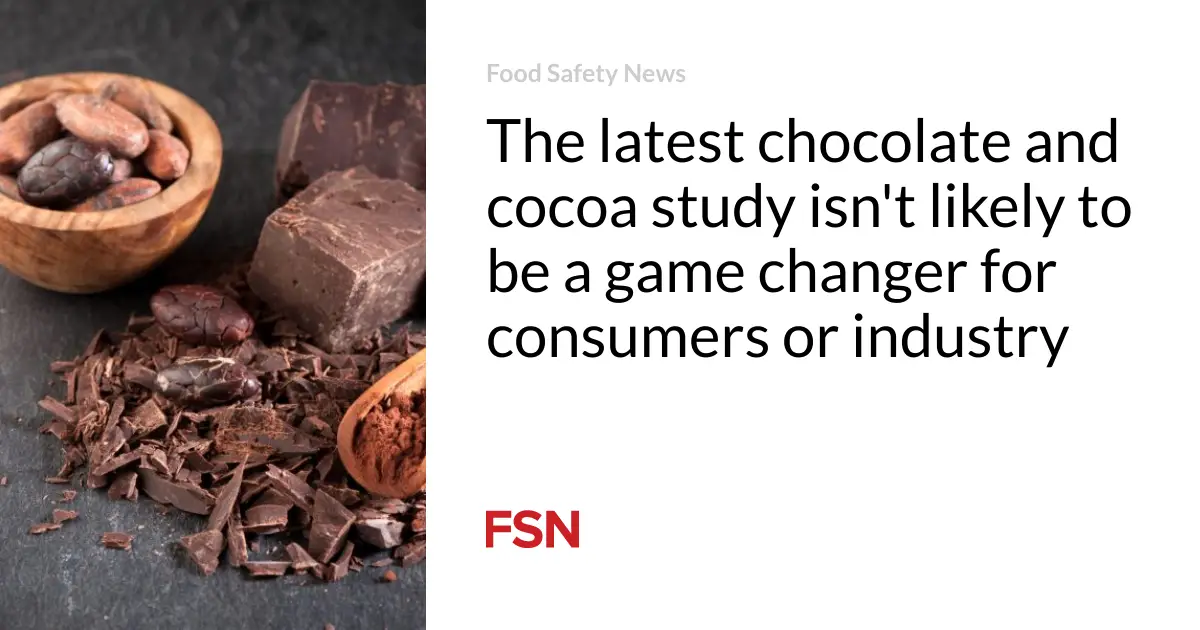
Makers of chocolate and cocoa products have been waiting for the latest metal analysis, which was released early Wednesday by the journal Frontiers of Nutrition:. The multi-year heavy metal analysis of 72 dark chocolate and cocoa products in the USA is based on data sets beginning in 2014,
The new study isn’t likely to change much. Chocolate and cocoa may contain some heavy metals, but are largely seen as safe to eat in moderation.
According to Frontiers of Nutrition reports, contamination of cocoa-containing products, such as dark chocolate, with heavy metals, including lead, cadmium, and arsenic, has been reported in the US. It said a formal exploration into the significance of this contamination, nor multi-year trends in the degree or scope remain unresolved.
The study, which is from George Washington University and covers 2014 to 2022, collected 72 consumer cocoa-containing products that were purchased and analyzed for heavy metal contamination with lead (Pb), cadmium (Cd), and arsenic in 4 distinct cohorts (2014, 2016, 2019, 2022).
The thresholds used to assess heavy metal contamination set to California Prop 65 maximum allowable dose levels (MADLs) of 0.5 mcg/day, 4.1 mcg/day, and ten mcg/day for Pb, Cd, and As, respectively.
The GWU analysis reports that 43, 35, and 0 percent of the products tested exceed Prop 65 MADLs for heavy metal concentrations, respectively, of Pb, Cd, and As, while 97.2 percent (70 of 72) fall below US FDA IRL limits established for Pb.
Further, the study reported that median concentrations of each metal tested were lower than even the conservative Prop 65 MADLs, indicating a potentially large effect of product outliers.
The research indicates that heavy metal contamination — in more than half of the products tested — may not pose any appreciable risk for the average person when consumed as a single serving; however, consuming some of the products tested or more than one serving per day in combination with non-cocoa-derived sources of heavy metals may add up to exposure that would exceed the Prop 65 MADLs. Notably, “organic” products were significantly more likely to demonstrate higher levels of both Cd and Pb.
The National Confectioners Association (NCA), a Washington, D.C.-based trade association representing the nation’s candy makers, has been waiting to respond to the GWU study.
NCA said the study is “missing important context” and leaves questions unanswered.
It tells the public that chocolate and cocoa are safe to eat and can be enjoyed as treats as they have been for centuries. NCA says, “Food safety and product quality remain our highest priorities, and we remain dedicated to being transparent and socially responsible.”
It quotes FDA as saying: “While the presence of cadmium and lead in chocolate has been the subject of considerable media attention, experts from around the world have found that chocolate is a minor source of exposure to these contaminants internationally.”
The GWU study concludes, “. . . if contaminated products are consumed in small amounts and infrequently by most, these contaminants may not be a public health concern. . .”
NCA says chocolate and cocoa products fit this description, according to the FDA . Consumers understand that chocolate and candy are occasional treats and not center-of-the-plate foods. According to the CDC’s National Health and Nutrition Survey (NHANES), people in the U.S. enjoy chocolate and candy 2-3 times per week, averaging just 40 calories per day and about one teaspoon of added sugar per day.
The chocolate and cocoa industry agreed in 2018 to a Consent Judgment in California. The Superior Court of the State of California, San Francisco County, granted a motion to enter the Consent Judgment on February 14, 2018, which remains in effect. The Consent Judgment established concentration levels for both lead and cadmium that supersede the state’s Office of Environmental Health Hazard Assessment MADLs for cocoa and chocolate products.
(To sign up for a free subscription to Food Safety News, click here.)







